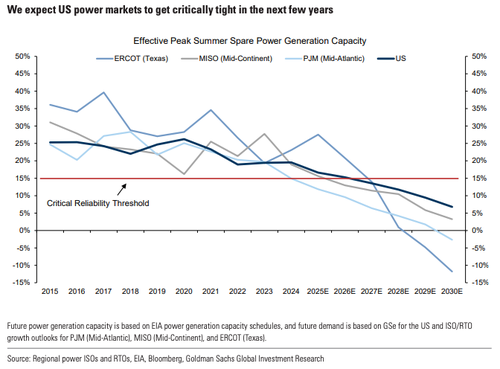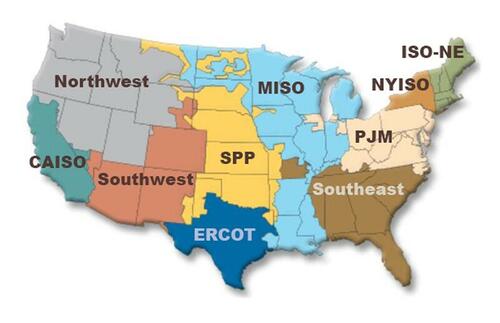
US Power Grid „Getting Critically Tight” — Time To Consider Backup Power At Home
A new Goldman report paints a very troubling picture of the U.S. power grid, which appears to be entering a dark period within the next few years where power supplies may no longer meet surging peak summer demand. With spare generation capacity dwindling, the risk of rolling blackouts and sharp price spikes is rising. All signs point to one conclusion: it might be time to purchase a whole-house generator.
Goldman analysts Hongcen Wei, Samantha Dart, and Daan Struyvenn note that power demand has been surging across the U.S. in recent years, driven by a combination of onshoring-related electrification, the growth of electric vehicles, and the rise of energy-intensive data centers (read: Next AI Trade).

Wei forecasts this trend will only accelerate, anticipating 2.5% annual U.S. power demand growth through 2030. However, the buildout of stable power generation, particularly „on-demand” sources such as natural gas and coal, has severely lagged behind.
One primary concern highlighted by the analysts is that while solar and wind capacity have expanded rapidly, their weather-dependent nature makes them unreliable during peak heatwaves, precisely when demand is highest. At the same time, the buildout of natural gas power generation has slowed due to soaring costs and limited turbine supplies.
The analysis indicates that the U.S. will dip below the industry-recommended 20% reserve margin this year, with national effective spare capacity projected to decline to an alarming 14% by 2027. Once this margin drops below 15%, the risk of grid reliability issues soars.

The unfolding situation on a grid-by-grid basis:
-
PJM (Mid-Atlantic): Expected to breach critical levels this summer, with spare capacity falling from 15% in 2024 to just 6% by 2027.
-
MISO (Mid-Continent): Will hit critical thresholds by 2026, due to insufficient generation additions and rising demand.
-
ERCOT (Texas): Temporarily buffered by renewables, but projected to fall into critical territory by 2028. Already, Texas shows the highest price risk premiums during peak demand months.
Map: US Power Grid

None of this should come as a surprise to readers, given the aggressive push for radical green energy policies under the Biden-Harris regime—policies that have prioritized the rapid phase-out of stable fossil fuel generation in favor of intermittent wind and solar. To some, the resulting premature transition to clean energy feels less like mismanagement and more like a deliberate act of sabotage.

PJM and MISO grids have already fallen below the critical reliability threshold…

ERCOT will slide under that level in 2028.

The analysts outlined that structural tightening of the power market has implications:
- Price Volatility: As reserve margins shrink, volatility and price spikes during heatwaves will become more common
- Investment Signals: Power suppliers must accelerate generation and storage investment plans.
- Risk Management: Consumers and institutional investors should hedge against rising regional power prices.
- Policy Reform: There may be renewed pressure for regulatory action to prevent further coal shutdowns and accelerate permitting for gas infrastructure.
Ahead of June, PJM warned about the „growing risks” of summer power shortages. This comes a little more than a month after Spain experienced a 'net zero’ death after failing green energy sparked a nationwide blackout.
PJM’s warning about potential summer shortfalls is a direct consequence of aggressive net-zero and green energy policies, which have destabilized power grids and driven prices higher—particularly in Mid-Atlantic states governed by far-left lawmakers.
Goldman Says Mid-Atlantic Power Prices „Finally Caught Up To AI Data Center Load Growth Story” https://t.co/6BInBek7Zz
— zerohedge (@zerohedge) August 4, 2024
It’s now up to the Trump administration to push for the restoration of reliable fossil fuel generation to reestablish grid stability (some good news so far) to avert blackouts.
What a disaster: radical green politicians and their de-growth climate policies have pushed America’s power grid into a state of instability. The question now is: mismanagement or sabotage?
It’s time to consider a whole-house generator to mitigate the future risks of power blackouts.
Tyler Durden
Thu, 06/05/2025 – 19:40











![Sąd pokazał jak obliczyć zachowek od mieszkania 191 500 zł. Dla córki, syna, wnuka. Obliczenia. Zasady. Wzory [Przykład]](https://g.infor.pl/p/_files/38265000/podwyzki-38264590.jpg)


